Last Updated on April 26, 2023
Despite their muscled exterior and worried wrinkled expression, Boxers are lovable, fun-loving, energetic family dogs.
Also known as the German Boxer or Deutscher Boxer, this purebred is a protective watchdog and sweet-tempered cuddler, making it a great companion for kids.

Is the Boxer the family guardian you need? Read on to learn all you need to know about these playful pups.
Quick Navigation
- 1 The History of the German Boxer
- 2 What Does a Boxer Look Like?
- 3 Temperament: Is a Boxer a good family dog?
- 4 How to Take Care of Your Boxer Dog
- 5 Health Issues: What is the Lifespan of a Boxer?
- 6 How Much is a Boxer Puppy?
- 7 Other Lovable Boxer mixes
- 8 Is the Boxer Dog Right For You?
- 9 Further reading: Similar breeds to the Boxer
The History of the German Boxer

Boxers originated in Germany in the late 19th century. It’s believed that they’re bred down from a large hunting dog called a Bullenbeisser, which means “bull biter.”
Some say they’re also related to Bulldogs, such as the Old English Bulldog and Mastiffs.
And because of their skill at big-game hunting, like easily taking down wild boars and bears, they were also used for dog fighting and bull-baiting.
Their name is actually from the sport of boxing. They defend themselves by standing up on their hind legs and using their front paws to box.
Owners of this breed may have noticed it in their modern Boxers, which makes playtime entertaining!
But these working dogs are naturally task-driven and helpful. They even worked as police dogs in Germany.
By 1895, a club in Munich dedicated to the breed was established. They developed the first Boxer standards to serve as a guide for breeding. Then, they started a dog show to display their beloved Boxers.
After World War I, this canine arrived in the United States. Soldiers returned home from war with Boxer dog mascots, where the crowds went wild, and Americans fell in love with them.
The Boxer was one of the first breeds recognized by The American Kennel Club (AKC) around 1904 as part of their Working Group.
Boxers continued to gain popularity in the US, ranking in the top 10 most popular breeds for the past decade. This purebred dog ranks 11 out of 196 in AKC breed popularity.
What Does a Boxer Look Like?
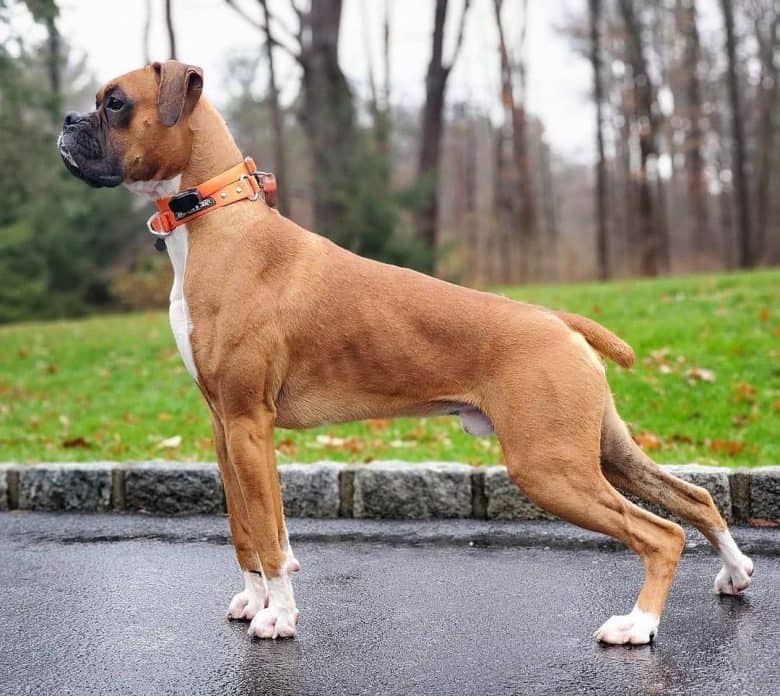
Boxer dogs look tough with their broad chest, muscular body, and a jaunty walk. They have a powerful jaw with an underbite, a regal, brachycephalic (squashed) head, and a short muzzle.
Their droopy, dark brown eyes unveil their inner playful personality.
You may notice a slight difference between German Boxers and American Boxers. German Boxers have larger heads and a larger, more muscular build.
And their ears fold naturally. If you see a Boxer with their erect ears, it means they’ve been cropped. Similarly, they have naturally short tails, but some owners have the tails docked or removed.
The AKC breed standard states that cropping and docking maintain the breed characteristics, although more Boxer owners leave their pups au naturel.
How big do Boxer dogs get?
Boxers are medium- to large-sized canines that take 3 full years to reach their full-grown size. Adult males are 23 to 25 inches tall (57 to 63 cm) and 65 to 80 pounds (30 to 36 kg).
Female Boxers are significantly smaller, with a height of 21 to 24 inches (53 to 61 cm) and a weight of 50 to 65 pounds (22 to 30 kg).
With their size alone, Boxers do best in homes with an outdoor yard for them to explore freely. They can adapt to apartment living as long as they have plenty of exercise every day.
If you love this breed but hoping to get something smaller, Miniature Boxers might be the pooch for you. They’re actually mixed breeds that offer some of the purebred Boxer traits in a more compact package.
Mini Boxers usually grow to an average height of 15 to 22 inches (38 to 56 centimeters ) tall and weigh 25 to 55 pounds (11 to 25 kg).
Also read: Boxer Growth and Weight Chart
A slick coat for a good-looking doggo
The Boxer is known for its smooth, shiny, short coat. Its face can have a solid black mask, a black mask with white markings, or just white markings. White markings are usually only on the feet and belly.
Coat colors can range from fawn (light tan, reddish-brown, or mahogany) to brindle (tiger-striped black lines on a fawn coat) or white.
Some Boxers may appear to have a solid black coat called reverse brindle. It just means that the brindle stripes are so thick that they mask the fawn coat underneath.
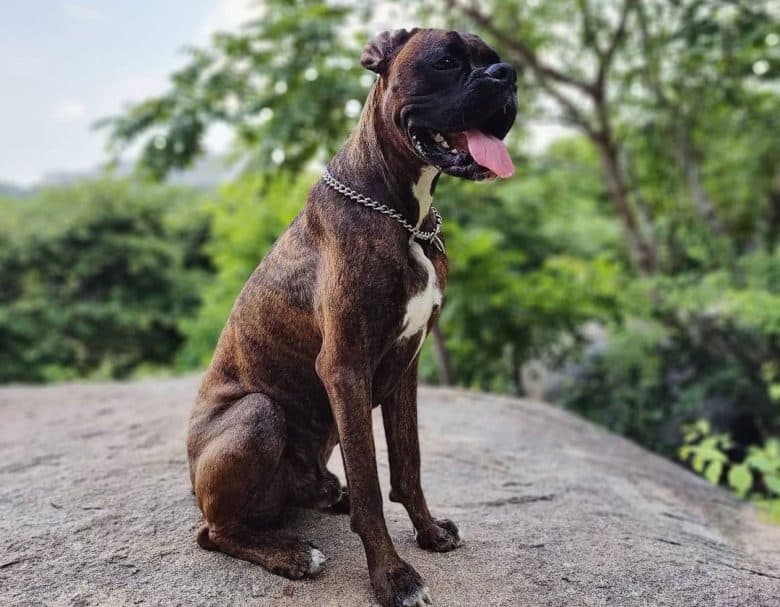
20 to 25 percent of Boxers will be born with white coats.
The AKC sets a standard that Boxers should have two-thirds of their coats as fawn or brindle, making white boxers disqualified from participating in an AKC dog show.
White Boxers are NOT albino. They just inherited the extreme white spotting gene from both of their parents. They lack the right amount of pigment and need extra loving care to prevent getting UV damage.
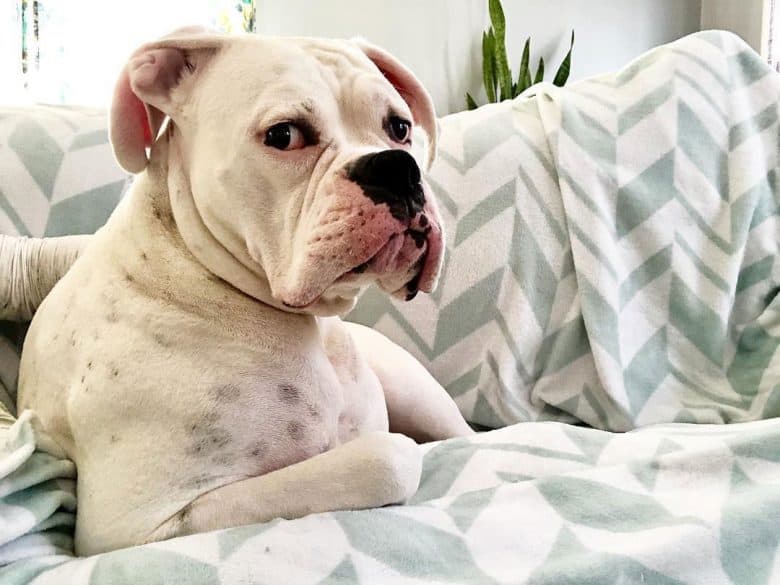
Temperament: Is a Boxer a good family dog?
Despite their powerful build, Boxers have an innocent heart of gold. They make excellent family dogs and beloved babysitters due to their protective and loyal personality.
They’re known as “shadow” dogs for following their owners everywhere.
Be cautious when there are little ones around, though. These fidos are often enthusiastic and excitable.
One of the things Boxers are known for is the “the kidney bean” dance because they twist their bodies into a semi-circle when they’re happy.
It’s quite an adorable dance. We found this video of a Boxer being wiggly happy and thought you might want to see it, too:
These affectionate fur angels love giving cuddles and slobbery kisses to their favorite people. As big as they are, Boxers will often try to sit on their owner’s laps.
With proper training and early socialization, this purebred can be gentle and patient with small children, making it a great family pet.
Fun fact:
Boxers are one of the fastest known dog breeds. They can run 38 to 45 miles per hour! Their gait is athletic and joyful at the same time. Full of bubbling energy, they love to jump, twist, spin, and wiggle.
Are Boxers dangerous?
Most canines with menacing or intimidating looks are NOT aggressive at all, and that includes the Boxer. If you heard stories about attacks linked to this pup, it’s because they’re trained to do so.
Having your Boxer puppy trained and socialized as early as possible will help him get comfortable around strangers and be well-behaved. They do well in homes with other pets, as long as they’re raised together.
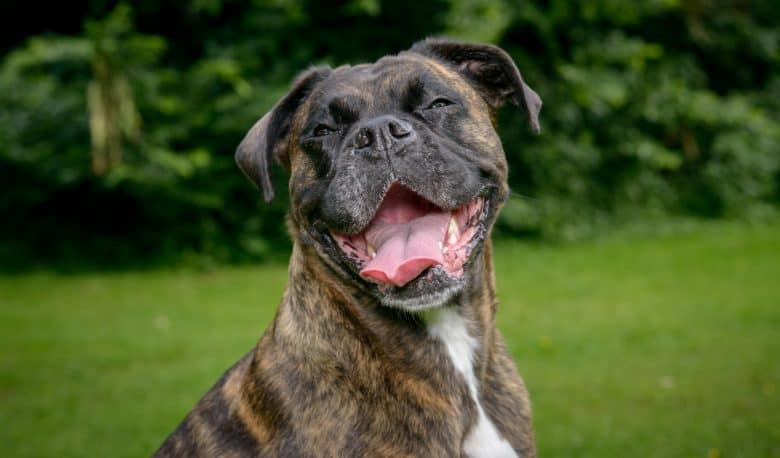
You can count on Boxers to be excellent watchdogs, too. They’re fearless, courageous, and always alert. They’re highly protective and will warn you when people are approaching your home.
Don’t worry. They DON’T bark excessively. They may be vocal dogs that will growl and snort, but they mostly make a cute “woo-woo” sound to communicate.
Those Boxers who are barking more often may be suffering from separation anxiety.
Remember that they’re clingy dogs who prefer to follow their human, and they easily get bored, so it’s best not to leave your fur baby alone for long periods.
Luckily, these intelligent canines are moderately easy to train. You just have to be a firm leader and mix up the activities or games to keep your pet engaged and obedient.
Watch out for dominant traits, as these can lead your Boxer to be a bully.
How to Take Care of Your Boxer Dog
Your goofy companion is low-maintenance when it comes to grooming but high-maintenance when it comes to lifestyle.
They drool, snore, take up space, and shed. They need devoted attention and companionship.
How much exercise should your Boxer get?
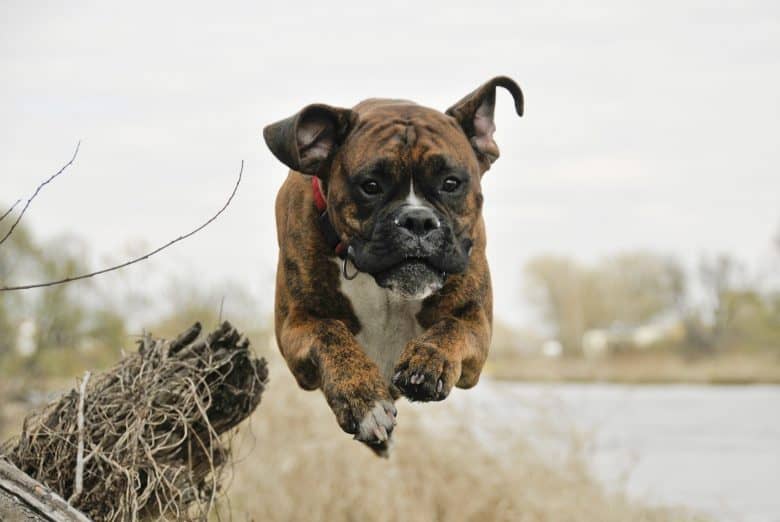
Boxers that are adult dogs require 40 minutes to 1 hour of daily exercise. And don’t think that a quick walk around the block will cut it because it won’t.
They thrive on energetic play that satisfies their need for physical and mental stimulation.
There’s fetch, dog sports like agility, and even swimming. Though they’re not natural swimmers, you can give your fur baby a vest so he can enjoy the lake or pool.
It’s best to know that Boxers have a high prey drive, so keep activities in a safely enclosed space, like a fenced yard. When going for a walk, hike, or run, keep your doggo on a leash.
Breeds with high energy levels should be able to play whenever possible. If they get bored or don’t get enough exercise, you can expect destructive behaviors to develop.
Do Boxers shed a lot?
The grooming needs of your Boxer are relatively easy and low maintenance. This breed is not hypoallergenic and is considered a moderate shedder, but it can be dealt with weekly brushing.
If you can do it daily for a few minutes, the better.
However, Boxers are known to drool excessively, so if you’re grossed out by slobber, this might not be the fido for you.
Another interesting fact about Boxers is that they groom themselves like cats, so they’re pretty clean for a pet and aren’t smelly.
They only need a bath once a month. Pay extra attention to those wrinkles and clean them with a damp cloth.

Just because they’re quite big dogs doesn’t mean you can let your pet stay outdoors. This breed isn’t a hardy outdoor canine as they’re sensitive to extreme temperatures.
Their short coat can’t protect them from the cold weather, and their short nose makes the summer season challenging. All pets should stay indoors with their family.
Feeding: How much food should a Boxer eat a day?
The answer to this will be different depending on every dog. Pet parents should always consider their fur baby’s breed size, weight, age, and health.
But generally, Boxers require 2.5 to 3 cups of high-quality dog food divided into two meals daily.
When we say high-quality, the recipe you pick should have real protein listed at the top of its ingredients. It should also not include by-product meals and fillers.
It should also be a high-protein diet, given this breeds’ high energy levels.
Proper nutrition includes treats, but steer clear of those that are too high in calories because Boxers are predisposed to obesity.
Boxers are also susceptible to gastric dilation-volvulus or bloat, which is where their stomach can fill with air, causing gastric torsion if it gets severe.
Always keep an eye on your Boxer after eating to ensure they digest their food properly and are not in any pain.

Health Issues: What is the Lifespan of a Boxer?
The Boxer dog breed is generally healthy with an average life expectancy of 10 to 14 years, but some can suffer from a few health problems, like genetic disorders.
As we mentioned earlier about their appearance, this breed is brachycephalic, which causes snoring, breathing issues, and upper respiratory problems.
Respiratory Distress Syndrome is common in these breeds, so keep an eye on your Boxer when he’s exercising to ensure there’s enough oxygen flow.
Consult with your veterinarian if you notice your pup is breathing too loudly, coughing, or having bluish lips and gums.
They’re also prone to inherited heart diseases. The most devastating condition is Boxer cardiomyopathy, which is a fatal heart disease.
They also can inherit aortic stenosis or subaortic stenosis, which is a narrowing of the aortic valve.
There are recommended health tests that all breeders should screen for, including:
- Degenerative myelopathy DNA test.
- ARVC DNA test
- Boxer cardiomyopathy
- Aortic valve disease
- AS/SAS Cardio
- Thyroid evaluation
- Hip and elbow evaluation (for joint problems and hip dysplasia)

Cancer is the leading cause of death in this breed. They rank as the number 1 purebred dog to develop mast cell tumors.
White Boxers are especially susceptible to skin cancer. So if you have a white instead of a fawn Boxer, always put zinc-oxide-free sunscreen on your light-colored pup when outdoors.
Did you know:
20 percent of white Boxers are deaf, so white Boxers are not supposed to be bred. This also includes Boxers who carry the extreme white spotting gene.
Boxers can also inherit eye conditions like corneal dystrophy, where you may notice an opaque spot in the center of their cornea.
Demodectic mange is another genetic health condition to watch out for. The Demodex mite can cause red patches of scaly skin, bald spots, or infections. Boxers are prone to allergies, which can cause itchy skin.
How Much is a Boxer Puppy?
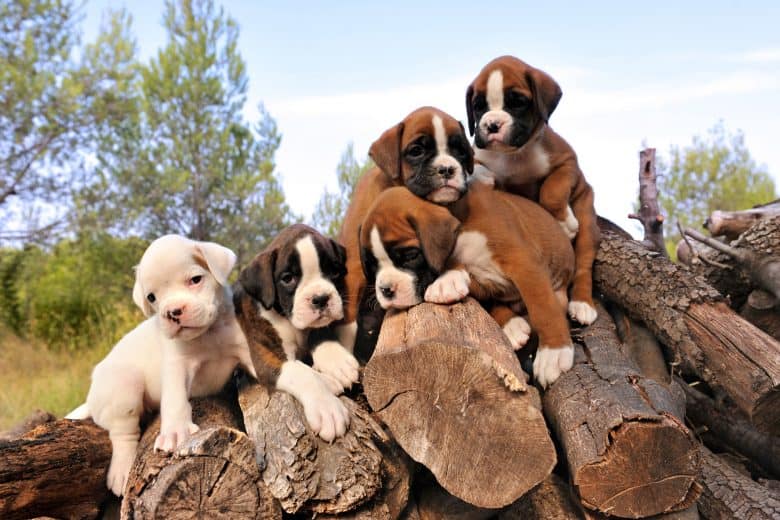
Depending on factors like the kennel’s popularity, the breeder’s location, vaccinations, and the lineage, the average price of a Boxer puppy is around $500 to $2,800.
The number of available pups can affect the cost, too. This breed’s litter size can have 5 to 10 Boxer puppies.
After purchasing your pup, you should know that the expenses don’t stop there. You have to have your new fur baby checked by the vet, then the monthly and emergency medical costs, food, bed, crate, and many more.
If you’re prepared for all that, congratulations! You’re now ready to look for a puppy of your own!
Boxer Dog Breeders
Just by doing a quick search online, you’ll find plenty of Boxer puppies for sale.
But before taking money out of your pocket, you have to take vital steps to ensure you’re bringing home a healthy puppy that will be with you for a long time from a responsible breeder.
First, do your research about the breeders or kennels you’re interested in. You can also check their social media and see what previous clients are saying about their experience.
If possible, request to visit the puppy to see it personally and observe its littermates, parents, and its environment. The way a dog reacts when seeing strangers or its current handler says a lot about how they’re treated and cared for.
Once you’re confident, make sure the contracts detail the agreement you made with the breeder. You should also be able to see proof of health screenings of their breeding stock and vaccinations of the pup.
Are you excited to go window shopping for a Boxer puppy? We highly recommend going through the AKC Marketplace.
Another option is contacting the American Boxer Club for a breeder referral.
Boxer Dog for adoption
Would you prefer to rescue an adult Boxer? Many pets end up in shelters and rescues because their previous owners got overwhelmed by this breed’s high-energy needs. Now, many of them are looking for their forever home.
The American Boxer Club also has a list of Boxer Rescue websites for organizations within the United States.
Other Lovable Boxer mixes
If you were thinking of adopting and you noticed that there are a lot of crossbreeds from those rescue sites, you may agree with us that they’re all undeniably adorable!
Some of them are even capable of being guard dogs. If you’re curious about them, here are a few of the Boxer mixes you ought to meet:
- Pitbull Boxer Mix (AKA Bullboxer Pit)
- Boxer Lab Mix (AKA Boxador)
- German Shepherd Boxer Mix (AKA Boxer Shepherd)
Is the Boxer Dog Right For You?
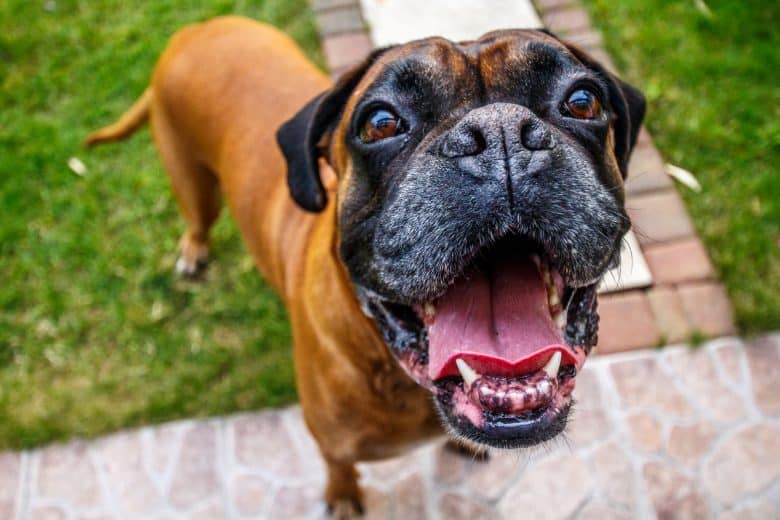
Yes, if you’ve always wanted a canine companion that’s goofy, smart, and high-spirited. But just like us, every breed has its flaws.
We just have to learn how to deal with them and still see the beauty behind that wrinkly face, droopy eyes, and mischievous personality.
We don’t even question why the Boxer is one of the most popular dog breeds in the United States.
And if you’re nodding your head for all the great things that define the Boxer, then it might be the best dog for your family.
All that slobber, moderate shedding, and bouncy personality will be worth it whenever this cuddly and clownish breed entertains you.
Do you have a Boxer? Or thinking about getting one? Tell us about your experiences or thoughts in the comment box below!
Further reading: Similar breeds to the Boxer
Cess is the Head of Content Writing at K9 Web and a passionate dog care expert with over 5 years of experience in the Pet Industry. With a background in animal science, dog training, and behavior consulting, her hands-on experience and extensive knowledge make her a trusted source for dog owners.
When not writing or leading the K9 Web content team, Cess can be found volunteering at local shelters and participating in dog-related events.
